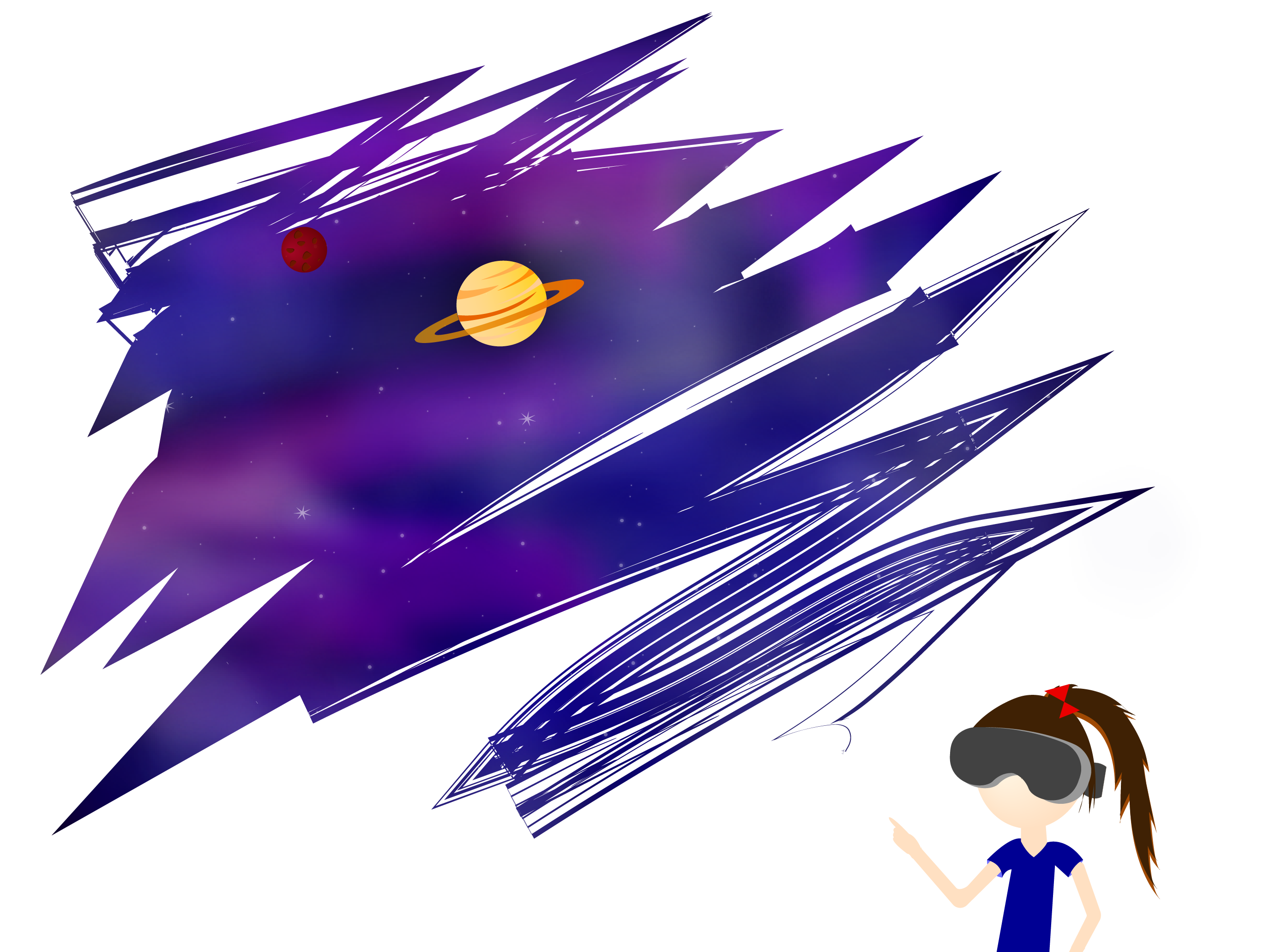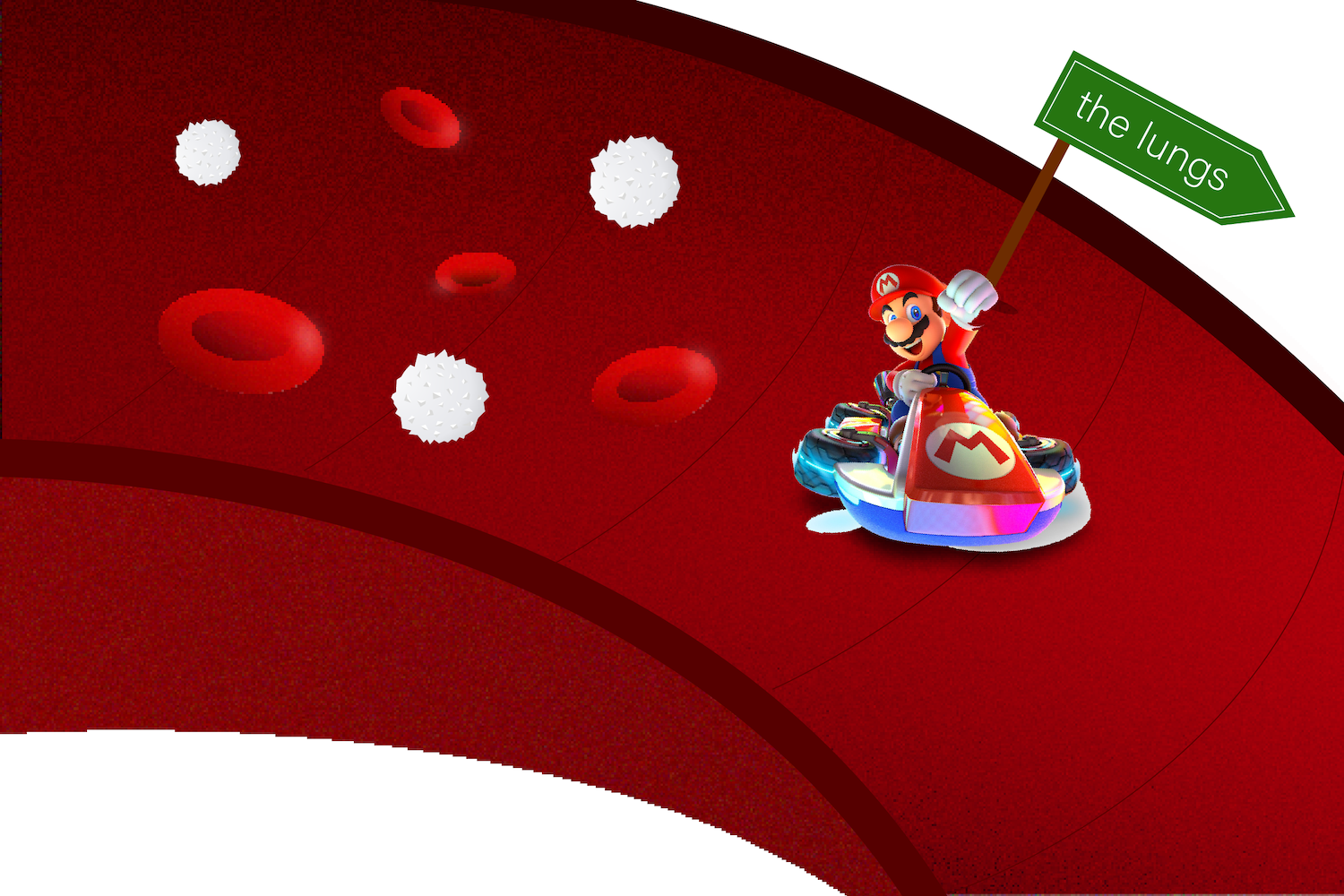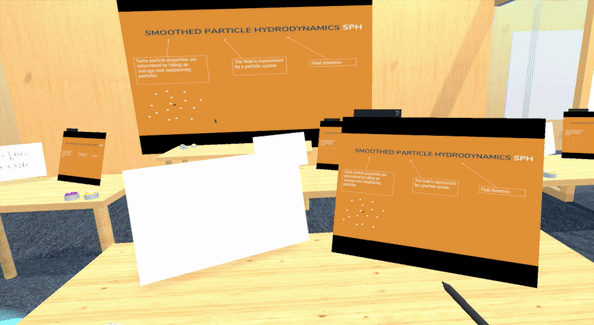
Illustration by Karena Cai for Caltech Letters
Viewpoint articles are a vehicle for members of the Caltech community to express their opinions on issues surrounding the interface of science and society. The views expressed here do not necessarily reflect the views of Caltech or the editorial board of Caltech Letters. Please see our disclaimer.
When I signed up to tutor underserved high school students at the start of the COVID-19 pandemic, I wasn’t quite sure what to expect. I had tutored before, but never through a computer screen, and I was anticipating challenges. However, when teaching a high school biology module on population genetics, I discovered a koi pond simulation1. The student and I watched as the fish in our virtual pond changed from orange to white over simulated generations, with young fish appearing and old fish disappearing. With just a few buttons, the student could adjust the parameters that affect the rates of evolutionary change in the koi population, like the number of fish and rate of genetic mutation, and rerun the simulation. As the koi changed from orange to white faster or slower, I saw the principles of evolution and genetics begin to click into place for the student. While this koi pond simulation may not have the aesthetics and user experience of today’s most popular video games, I was still impressed. The use of interactive virtual games was certainly not a widely available learning tool when I was a high school student, but over the past year of tutoring, I repeatedly discovered that virtual games are an effective way to teach.
I might not have found the koi pond simulation if the COVID-19 pandemic had not forced me to meet with my student remotely. During the pandemic, many teachers turned to new virtual tools out of necessity, but even as many students return to the classroom, interactive and engaging virtual worlds could continue to be a valuable resource for teaching.
The video game industry and the rise of virtual reality (VR) have laid the groundwork to make science education virtual. People who play video games spend an average of 7 hours a week in the virtual world2. In America, 60% of 18-29 year olds are gamers3. Not only do more young people play video games, but they also spend the most time, averaging 8 hours per week with a preference for strategy and puzzle games2, 3. Young gamers demonstrate incredible focus, persistence, attention to detail, patience, and creativity as they conquer each challenge and improve towards mastery. These are some of the same traits that are key to excelling in a different arena: science4,5. By adopting techniques successfully used in gaming, science education could more effectively captivate the interest of young people in primary and secondary school to improve scientific literacy and preparation for careers in science.
Immersive design is a key element that keeps people playing. Gamers are engrossed by well-developed characters and stories that require constant interaction6, 7. But it’s not just the story that keeps people hooked—background music8 and interactive, aesthetic graphics9 engage people in the virtual world. Elements of achievement and competition, such as the use of progress bars, level advancement, fake currency, prizes, and increased challenge as the user advances, help to keep gamers motivated and provide feedback6, 7.
While the use of virtual interactive environments is starting to trickle into classrooms, the immersive design of technologies like video games and VR could purposefully be applied towards making science education more engaging. Scientific objectives could be part of a story where the student is a key character that actively participates by advancing through the material. Through engaging music and graphics9, the virtual format could bring abstract ideas to life or create more authentic and inspiring visualizations of cells or ecosystems.
Unlike a large classroom, the video game experience can be very individualized. The gaming interface makes it possible for learners to receive instantaneous, personalized feedback on their progress toward mastering scientific concepts through repetition. Students come from varying backgrounds and skill levels, and with the customized options of a video game, students can complete side quests for supplementary material to reward curiosity, spend more or less time on topics catered to their unique strengths and weaknesses, and progress towards mastery in a way not possible in a traditional classroom. The video game format could make education more immersive, individualized, and therefore, effective9.
The design and mechanisms used in popular games can serve as inspiration to guide the gamification of scientific concepts. Take Tetris, a tile-matching game in which the user manipulates tiles to fill gaps under increasing time pressure as the user advances. A similar setup could be used to teach DNA transcription to RNA, as the user matches complementary base pairs of DNA and RNA nucleotides. Alternatively, inspired by Mario Kart, blood cells could race through the circulatory system, refueling with oxygen at the lungs and even delivering medications to treat obstacles like clots. For a more creative or survival themed game, the user could ward off viral or bacterial infections by producing an antibody response or applying therapeutics while learning how they work.

Illustration by Karena Cai for Caltech Letters
Video games demonstrate a long-established ability to engage the public in everything from education to exercise. Wii Sports and Pokémon Go got users moving, off the couch and into the neighborhood respectively, gaining attention not only for their interactive formats, but also for their fitness benefits10,11. On the education front, Where in the World is Carmen SanDiego? incorporates history, geography, and culture as players follow the titular character on her global crime-solving missions12. The Oregon Trail similarly educates players on the harsh trials of the U.S. westward migration in the 19th century13. Both of these games have persisted in public consciousness years after they were first used in schools. The science-based television shows Bill Nye the Science Guy and The Magic School Bus and disease-combating board game Pandemic have also achieved mainstream popularity14,15. These successes show it is possible for broad science education to be engaging—perhaps now through a video game format.
Promising efforts to use virtual worlds to enhance science research and education are already underway. In the video game InCell VR16, the player races to save a human cell from destruction by a virus while learning biology concepts along the way. Use of VR technology in InCell VR and other games shows promise for making science education even more interactive and collaborative17,18. Use of VR for training in science-related professions is also expanding: neurosurgeons can now practice operating on a virtual brain19, and scientists at Purdue University are developing VR courses for training in cryo-electron microscopy20, the topic of the 2017 Nobel Prize in Chemistry. Such applications demonstrate the value of immersive virtual learning environments for technical education.
With the onset of the COVID-19 pandemic, teachers have had to adapt to a new age of “Zoom learning”. However, this isn’t the only way to approach remote learning. Since 2018, Caltech has also been developing a software prototype for a VR teaching space to provide a virtual environment for college-level education. In this virtual classroom, students have streamlined options to interact with the instructor, other students, and 3D scientific models, all with the click of a button21. Science teachers can use this technology to instantaneously assess understanding of the materials and rapidly customize activities to each student’s needs, creating a more personalized and immersive educational experience. Likewise, students can instantly and privately indicate confusion and get extra practice on difficult material, promoting inclusivity. Development of these new educational tools could not only facilitate more effective remote teaching during the current pandemic, but also expand the capabilities of future classrooms to tackle persistent challenges.

Illustration by Karena Cai for Caltech Letters
Despite the potential benefits of incorporating this immersive technology into schools, this objective faces the same major hurdle as most educational endeavors: money. Video gaming is a massive industry that generated $120 billion in revenue in 201922, but production costs can range in the millions for games with advanced graphics and modern software-development tools23,24. It is not clear if the government, schools, individuals, or some combination would contribute most to profits that drive production. Nevertheless, The Oregon Trail generated around ten million dollars in revenue annually by 1995, demonstrating the potential profitability of educational games25. The rising U.S. learning-based game market is also promising: valued at $2.4 billion in 2018, the value is projected to exceed $4 billion by 202426. Heavy collaboration between educators and game developers seems critical to create games that are both educational and engaging (and therefore profitable)27. However, the impact of even a great science game will only extend as far as the number of people it reaches. While games like The Oregon Trail show us that popularity and revenue are possible for educational games, disparities in technology access and public school funding remain a hurdle for video games to be a truly equalizing force in science education.
Combining immersive and entertaining virtual worlds with instructional design that meets learning objectives is key for this educational strategy to be successful. Using the interactive format of video games and VR in the classroom could not only increase engagement but also make science education more personalized, inclusive, and therefore, effective. Gamification of education to reach a diverse audience of young people may lead to a more informed world, increased appreciation for science, and preparation for a career in STEM. It is time VR headsets and game controllers made their way into the classroom, giving education an overdue technological upgrade to immerse students in science.
References
1:PopGen Fishbowl - Virtual Biology Lab.
2: The State of Online Gaming – 2019. Limelight Networks (2019).
3: [Brown, A. Who plays video games? Younger men, but many others too. Pew Research Center (2017)](https://www.pewresearch.org/fact-tank/2017/09/11/younger-men-play-video-games-but-so-do-a-diverse-group-of-other-americans/ (2017){:target=”_blank”}.
4: Burke, K. What Makes a Good Scientist? American Scientist (2017).
5: Jensen, D. G. & 2018. The core traits of career success. Science (2018).
6: Huotari, K. & Hamari, J. Defining gamification: a service marketing perspective. in Proceeding of the 16th International Academic MindTrek Conference 17–22 (Association for Computing Machinery, 2012). doi:10.1145/2393132.2393137.
7:Hamari, J. & Eranti, V. Framework for Designing and Evaluating Game Achievements. in DiGRA Conference (2011).
8:Mehta, R., Zhu, R. (Juliet) & Cheema, A. Is Noise Always Bad? Exploring the Effects of Ambient Noise on Creative Cognition. Journal of Consumer Research 39, 784–799 (2012).
9:Becker, K. & Parker, J. An overview of game design techniques. in Learning, Education and Games 179–198 (ETC Press, 2014).
10:Althoff, T., White, R. W. & Horvitz, E. Influence of Pokémon Go on Physical Activity: Study and Implications. J Med Internet Res 18, (2016).
11:Anders, M. As Good as the Real Thing? ACE Fitness Matters (2008).
12: Riviere, L. Where in the World is Carmen Sandiego? In the Classroom! Houghton Mifflin Harcourt (2019).
13: Farber, M. Oregon Trail as an Anchor for Interdisciplinary Learning. KQED (2017).
14:Council, N. R. Learning Science in Informal Environments: People, Places, and Pursuits. (2009). doi:10.17226/12190.
15:Jolin, D. The board games turning science into playtime. The Observer (2019).
17: Zimmerman, E. K–12 Teachers Use Augmented and Virtual Reality Platforms to Teach Biology. Technology Solutions That Drive Education (2019).
18:Thompson, M. M., Wang, A., Roy, D. & Klopfer, E. Authenticity, Interactivity, and Collaboration in VR Learning Games. Front. Robot. AI 5, (2018).
19: Erickson, M. Virtual reality system helps surgeons, reassures patients. Stanford Medicine News Center (2017).
20: Gonzalez, B. et al. CryoVR: virtual reality training and outreach tools for cryo-EM. Acta Crystallographica Section A: Foundations and Advances vol. 75 a66–a66 (2019).
21: Lombeyda, S. ERT: an Enhanced Reality for Teaching. Open Virtual Reality for Art and Sciences at Caltech.
22: 2019 Year In Review. SuperData, a Nielsen Company (2020).
23:C, T. Why video games are so expensive to develop. The Economist (2014).
24: Koster, R. The cost of games. VentureBeat (2018).
25:LaFrenz, D. E. Oral history interview with Dale Eugene LaFrenz. (1995).
26:ltd, R. and M. Game-Based Learning Market: Global Industry Trends, Share, Size, Growth, Opportunity and Forecast 2019-2024. Research and Markets (2019).
27:Buday, R., Baranowski, T. & Thompson, D. Fun and Games and Boredom. Games Health J 1, 257–261 (2012).




